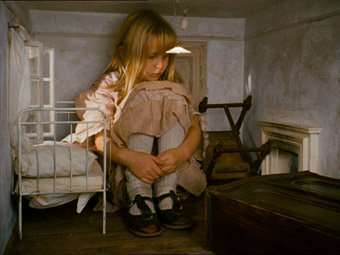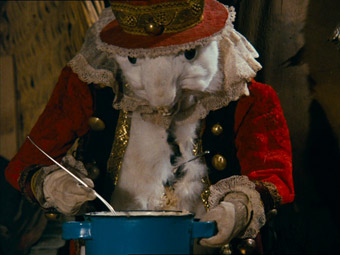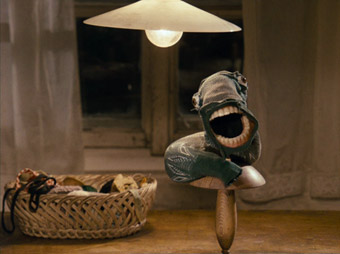| |
"Now you will see a film made for children. Perhaps. But I nearly forgot! You must close your eyes. Otherwise you won't see anything." |
| |
Alice introduces her adventures |
The Reverend Charles Lutwidge Dodgson did write a lot of nonsense. Fabulous nonsense, of course. Under his more familiar pen name of Lewis Carroll, he created the most famous of all so called 'nonsense poems' in his 1872 Jabberwocky, and what is widely regarded as the greatest example of nonsense literature in his 1865 novel Alice and her Adventures in Wonderland, which is regularly abbreviated to the film-friendly favourite, Alice in Wonderland. It's a story that almost everyone has at least heard of and that many will have read or at least watched in film form. And there have been many such cinematic incarnations, from Cecil Hepworth and Percy Stow's 1903 silent adaptation (which is included on this very disc) through Disney's celebrated 1951 animated version through to Tim Burton's $200 million live-action take, which was also financed and produced by Disney.
Looking back, it's easy to appreciate the surrealism of a story that was written over 50 years before the term surrealism was first coined, and it's Carroll's command of these elements that gives the story its lasting appeal for adults and children alike. For kids, Alice's adventures are an extension of the journeys their untrained imaginations allow them to take on on a daily basis, while for adults they can re-awaken the dormant memories of a childhood lost. The Wonderland of the title is the essence of surrealism, a world ruled by the fractured and twisted logic of dreams in which every object and encounter is simultaneously magical and potentially threatening. It's perhaps no surprise that Salvador Dali, one of the Surrealist movement's most famous sons, produced a series of striking illustrations for Carroll's novel that are now one of the most sought after collections of the artist's work.*

The nature of the story tends to lend even the most populist film adaptation a surrealist sheen, but most tend to play more as family-friendly fantasies, having fun with elements that have equal potential to be dark and disturbing, at least to adults whose lives are, by necessity of day-to-day survival, ruled by a logic that the novel rejects. Enter Jan Švankmajer, the rightly celebrated animator of Prague and a surrealist in the true artistic sense of the term. If the name is new you – and I guess it's always possible – then I've made my case for the man as one of film history's greatest and most influential film artists in my coverage of the BFI's superb Jan Švankmajer: The Complete Short Films, which you can read by clicking on that title.
Alice was Švankmajer's first feature-length film, a long-cherished project that saw a story constructed from child-like imaginings paired with a filmmaker whose work has been shaped in part by his own childhood fears. In this respect Alice is both an adaptation and a reinterpretation of the original text, one surprisingly faithful to the story, but that abstracts and expands on the detail, transforming Carroll's imaginative dream-like fantasy into the stuff of discomforting nightmares. The fabled White Rabbit is here a stuffed and case-enclosed animal (I'm betting that only Švankmajer, the Quay Brothers or Guillermo del Toro would put such a thing in a young girl's bedroom) that springs to life, pulls its nailed-down feet from the floor and dresses in clothing retrieved from a hidden drawer in the cabinet's earthen base. Armed with a pair of scissors, he smashes his way out and escapes through the drawer in an old wooden desk that sits isolated in a field that one wall of Alice's bedroom now opens onto. Alice gives chase, but her attempt to open the drawer and follow the creature is frustrated when the handle comes off in her hands and sends her sprawling to the floor, an action that is repeated every time she encounters a cupboard she needs to open.
Švankmajer hasn't so much visualised Carroll's story as used it as a framework on which to build. Here Wonderland is transformed into a domain of the dead, one whose creatures are constructed from the corpses, bones and skins of animals and where a stuffed and reanimated Rabbit leaks sawdust through wounds he has to repeatedly patch up through self-taxidermy. This is a world in a state of disrepair and decay, one furnished from long forgotten drawers of university science labs and curiosity shops, set in a past that was never present and populated by objects that were aged from birth. Characters and events from the original story have been transformed in a manner that is simultaneous disturbing and darkly comic. A clockwork March Hare has to be repeatedly wound up, the Caterpillar is a sock adorned with glass eyes and false teeth, and The Mad Hatter an expressionless wooden puppet who carries out his famed seat swaps like an hour-marking figurine from an elaborate cuckoo clock. In a particularly memorable sequence, the Dormouse who boats in on the sea of tears sets up camp on Alice's partly submerged head, hammering sticks into her skull, building a fireplace from stones and making kindling from her hair, which she stoically tolerates until he sets it alight.

Dialogue is delivered exclusively by Alice as the story's narrator, usually in extreme close-up and framed on her mouth, reflecting an oral fascination of Švankmajer's that a colleague of mine believes is worthy of potential psychiatric study. Indeed, there's a wealth of potential subtextual meaning to be gleaned from just about every scene, a famously dangerous pastime for an art movement where, if Buñuel and Dali are to be believed, nothing symbolises anything. Such complexity of surface detail, symbolism and potential meaning make watching Alice for the first time a little like eating a fifteen course meal whose every bite is loaded with exciting flavours, but whose density of content risks overloading the palette and exploding the stomach.
No compromise has made here to the feature length format, with the same attention to detail that so distinguished Švankmajer's short films visible in every frame here, the arachnid-like character movements and unsettling design tapping into the dark recesses of childhood fears in a manner specific to this uniquely gifted artist. It's a film peppered with sequences that border on the darkly sublime, and moments whose artistry registers in the blink of an eye (a personal favourite sees the Queen walk through – and for a split second meld with – the playing card from which she has been cut), and only trails off a little in the climactic courtroom scene, where dialogue and description start to dominate the action. But this is small gripe in an otherwise extraordinary work, one of those rare films in which an artist is perfectly matched to his chosen material, giving rise to an interpretation that richly compliments the original novel and, in its way, is one of the most faithful to its story and tone.
Alice is the latest of the BFI's admirable dual format releases containing both Blu-ray and DVD versions of the film. For review purposes we were provided only with the DVD, but on the basis of that the Blu-ray is going to look extraordinary. This is, quite frankly, one of the best-looking DVD releases I've seen all year, a beautifully restored and immaculately transferred version of this now 23-year-old Czech film, one whose crispness of detail, well balanced contrast and warm colour palette make me ache to see how the film looks in HD. The screen grabs here really don't do it justice. A very slight flickering is occasionally detectable, but you'll be pushed to spot anything in the way of dust or damage.

Both the English and – for the first time on UK DVD – the original Czech language tracks are provided here, both in Dolby mono 2.0 and both boasting an impressive clarity, enabling you to pick up on all of the subtleties of the sound mix, particularly the ticking clock that hovers quietly in the background in so many scenes. The minimal dialogue should make the English dub easier to accept than in more talk-heavy films, but with almost every line delivered in a close-up on Alice's mouth, the mismatch between what you hear and see is impossible to ignore.
Alice in Wonderland (8:38)
The very first film adaptation of Carroll's novel, directed by Percy Stow in 1903 before the average filmmaker had developed a strong sense of film storytelling or timing (just watch how long Alice's event-free encounter with the Cheshire Cat is held for). Given this was made at the birth of cinema, the effect shot that grows and shrinks Alice is rather good, and while the Queen's court sequence looks a little like a village pantomime version of the story, when the court members charge at Alice, their sheer weight of numbers make them a surprisingly intimidating force. The condition of the print is, unsurprisingly, rather poor, but the image is still very clear beneath the damage.
Elsie and the Brown Bunny (8:05)
A 1921 promotional film for Cadbury Brothers in which a young girl named Elsie is lounging on the riverbank reading Alice's Adventures in Wonderland and eating (Cadbury's) chocolates. She falls asleep and has a sugar-induced dream in which a brown Bourneville bunny takes her on a trip to see where chocolate is made, a jovial jaunt that involves peeking at cheerless assembly line factory workers and joining an exercise programme that would not be out of place in a Nazi youth camp. This advertising through association with established imagery looks forward to the vacuous nature of present day commercials, and despite some damage, the image is detailed and in surprisingly good shape. Unlike the previous film, this one plays without musical accompaniment.

Alice in Label Land (11:12)
A Central Office of Information film from 1974, sponsored by the Ministry of Agriculture, Fisheries and Food, in which the function and importance of the 1970 Labelling of Food Regulations is explained using characters from Carroll's Alice stories. A witty and appropriately surreal first half cites the story's famed "drink me" potion as a prime example of the dangers of poor labelling, and presents supermarkets as bemusing wonderlands that sell products like Mad Hatter Tea, Dormouse Butter and Mock Turtle Soup. Things settle down in a more straightforwardly instructional second half, from which I actually learnt a few things, proving the film is still capable of doing its job. Directed by Richard Taylor with voices supplied by Elizabeth Proud and William Rushton.
Stille Nacht II – Are We Still Married? (3:19)
A 1992 music video by the Brothers Quay for the song Are We Still Married? by 4AD group His Name Is Alive that displays a distinct Alice influence and was also included on the BFI's superb The Quay Brothers Short Films 1979-2003 set. It remains one of my favourite Quay Brothers shorts, its use of stop motion animation, surreal imagery and humour and ageing, time-trapped décor linking it directly to Švankmajer and Alice in particular.
Still Nacht IV – Can't Go Wrong Without You (3:47)
A second song from His Name is Alive, also directed by the Quay Brothers in 1993 and also featured on the Quay Brothers DVD set, revisits the imagery and characters of Are We Still Married? and is once again a playful and deliciously inventive piece with some suggestive undertones.
Also included with the release is a 34-page illustrated booklet with essays, film notes, biographies and credits, but this was not supplied with the review disc.
Švankmajer's first feature lived up to the considerable expectations created by his extraordinary cannon of animated shorts, and with no-one attempting emulate his style it still feels strikingly fresh and original today, and remains my favourite cinematic incarnation of Alice's story. The BFI's DVD looks terrific, sounds good, has some excellent extras, and we get to hear the original Czech language track for the first time on a UK disc. On top of that, you also get the film on Blu-ray. What more could you ask? Highly recommended.
* http://wonderland.paperstreetsupplies.com/gallery/dali-in-wonderland/ |